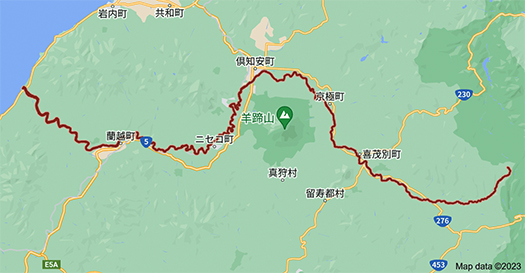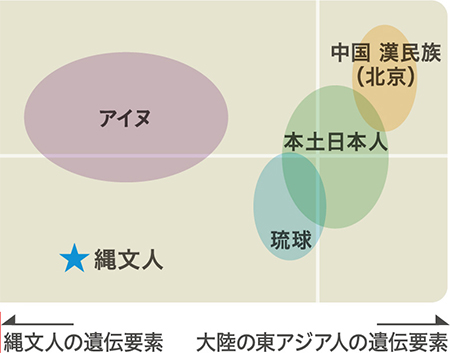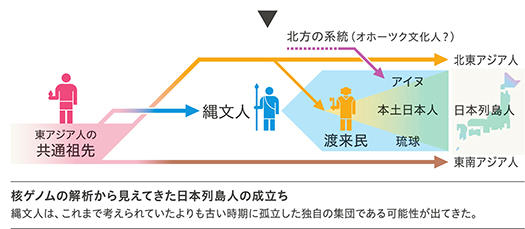
日本書紀の記述、斉明天皇の条での阿倍比羅夫の北征。古代世界で突然のように北辺の世界の記述が出てくることから、多くの研究が日本各地で行われてきている。北海道に暮らすものとして、何度もこのナゾに問いかけてきている。今回も現地周辺を行脚しながら想像力を巡らせてきていた。わたしとしては流域面積で北海道での6番目の「大河」である尻別川流路から、羊蹄山をつねに目標としながら上っていく山麓地域のどこかが比定されるのではないかと考えている。事実として「比羅夫」という地名も残されている。地名にはタイムマシンのように伝承などの故実が表現されていると考えるのが自然だと思うのです。
この日本書紀記述を巡っては倶知安町や余市町などで、後方羊蹄(しりべし)の政庁「郡領」はわが町存在したに違いないと論争が繰り返されてきた。いまのところ郷土の歴史の一断面として今後の調査に期待するところ。
一方で阿倍比羅夫が接触した人びとについて、いろいろな解析が進んできている。7世紀頃の北海道ではアイヌ文化はまだ成立せず、それ以前の「擦文」の人びとが文化圏を築いていた。以下の図表は、JT生命史研究館「縄文人の核ゲノムから歴史を読み解く〜国立科学博物館・神澤秀明」からの参照。https://www.brh.co.jp/publication/journal/087/research/1


この解析から想起できることは本土の人びとはより現在のDNAに近く、北海道島の人びとはより縄文人に近しい存在だったと。この分析からは、この時期に阿倍比羅夫と遭遇し「郡領」設置を進言したという人びとは、より縄文人の血が強い人びとだったことが想像できる。
北海道で活躍する考古学の瀬川拓郎氏の説によれば、この時期、アムール川河口周辺発祥の北方アジア系の「オホーツク文化人」の人びとが大型海獣の狩猟を中心としたライフスタイルで北海道のオホーツク沿岸地域に進出しており、かれらは交易を通じて日本社会との接点拡大を目指して日本海側にも進出していた。
そのことからこの後方羊蹄地域の縄文由来の擦文の人びとと緊張状態に陥り、そした背景から交易相手であるヤマト王権社会に「援軍」を請うた結果が阿倍比羅夫の遠征だったのではないかとされている。
奥尻島と想定される戦場で、実際に戦闘が行われ、阿倍比羅夫に従軍した副官クラスが奥尻島で戦死したとされている。
こういった北海道島の日本史との接触記録が、しかしその後、鎌倉期くらいまで眠ったようになる。遠征した阿倍比羅夫の血統は奥州安倍氏に連なるという説もある。その経済基盤としての対北方世界「交易」の実態は奥州藤原氏の奇跡的な栄華としても明らか。
日本の北方史は多くの魅力的なミッシングリンクに満ちている。
English version⬇
[People of the Jomon descendants who conversed with Abepirāu.
From Abephirao’s expedition onward, until the Kamakura period, there was a missing link in the world of the rise and fall of the Oshu Fujiwara clan, which is poorly documented. However, there were historical facts in Hokkaido. …
The description of the Nihonshoki, the northern conquest of Abenohirau in the article of Emperor Saimei. Because of the sudden appearance of descriptions of the northern world in the ancient world, a great deal of research has been conducted in various parts of Japan. As a resident of Hokkaido, I have repeatedly asked this riddle. This time, too, I have been exploring my imagination as I traveled around the area. I believe that the Shiribetsu River, the sixth largest river in Hokkaido in terms of watershed area, is located somewhere in the foothills of the mountain range, always with Mt. In fact, the place name “Hirao” has been preserved. I think it is natural to think that place names are like a time machine, expressing folklore and other historical facts.
There have been repeated disputes in Kutchan Town, Yoichi Town, and other towns over this Nihon Shoki description, arguing that there must have been a “county seat” of government in Shiribeshi in the backward direction in our town. At present, this is just one aspect of our local history, and we look forward to further research in the future.
On the other hand, various analyses of the people with whom Abenohirau came into contact are underway: the Ainu culture had not yet been established in Hokkaido around the 7th century, and the “Scrubun” people had established a cultural sphere before that time. The following figures and tables are from “Reading History from the Nuclear Genome of the Jomon People: Hideaki Kanzawa, National Museum of Nature and Science,” JT Biohistory Research Hall.
This analysis suggests that the people of the mainland were closer to the present DNA, while the people of Hokkaido Island were closer to the Jomon people. From this analysis, we can imagine that the people who encountered Abenohirau and advised him to establish a “county fiefdom” during this period were people with stronger Jomon blood.
According to the theory of Segawa Takuro, an archaeologist active in Hokkaido, during this period, “Okhotsk Culture people” of northern Asian descent who originated around the mouth of the Amur River expanded into the Okhotsk coastal region of Hokkaido with a lifestyle centered on hunting large marine animals, and they also expanded into the Sea of Japan side, aiming to expand their contacts with Japanese society through trade. They also expanded to the Sea of Japan side in order to expand their contacts with Japanese society through trade.
This may have led to tensions with the Jomon-derived Abrahamic people of the Yotei region, and the Abenohirau expedition may have been the result of their request for “reinforcements” from their trading partners in the Yamato Royal Society.
It is said that a battle actually took place on the supposed Okushiri Island battlefield, and that the second-in-command who served with Abepirāyu was killed on Okushiri Island.
These records of contact with Japanese history on the island of Hokkaido, however, then seem to have fallen asleep until about the Kamakura period. Some believe that the lineage of the Abenohirou expedition is linked to the Oshu Abe clan. The reality of “trade” with the northern world as its economic base is also evident in the miraculous prosperity of the Oshu Fujiwara clan.
Japan’s northern history is filled with many fascinating missing links.
Posted on 5月 7th, 2023 by 三木 奎吾
Filed under: 歴史探訪







コメントを投稿
「※誹謗中傷や、悪意のある書き込み、営利目的などのコメントを防ぐために、投稿された全てのコメントは一時的に保留されますのでご了承ください。」
You must be logged in to post a comment.